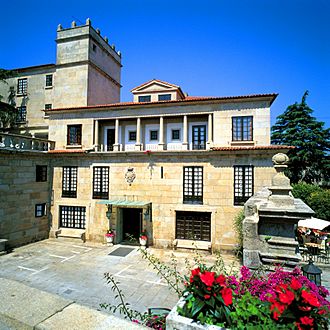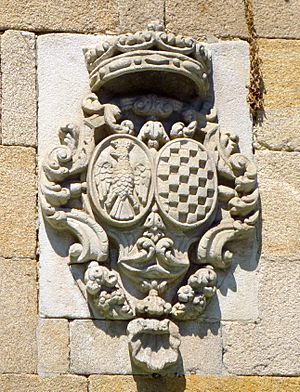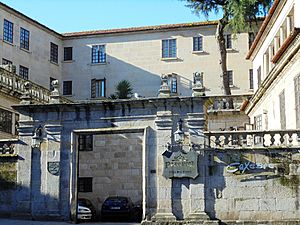Pazo of the Counts of Maceda facts for kids
Quick facts for kids Palace of the Counts of Maceda |
|
|---|---|
|
Pazo de los Condes de Maceda
|
|
 |
|
| Alternative names | Parador de Pontevedra |
| Hotel chain | Paradores |
| General information | |
| Type | Pazo |
| Location | Pontevedra, Spain |
| Coordinates | 42°26′03.1″N 8°38′45.9″W / 42.434194°N 8.646083°W |
| Construction started | 16th century |
| Completed | 18th century |
| Opening | 1955 (as a Parador) |
| Technical details | |
| Floor count | 4 |
| Design and construction | |
| Architect | Pedro de Monteagudo (18th century) |
The Palace of the Counts of Maceda, also known as Casa del Barón, is a beautiful old building in Pontevedra, Spain. It's a special type of Galician manor house called a pazo, built in the 1500s during the Renaissance period. Today, it's a fancy four-star hotel that's part of the Paradores group.
Contents
Where to Find It
This palace is on Barón street, right in the middle of the old town of Pontevedra. It's also very close to the old Burgo Bridge, which is a medieval bridge.
A Look at Its Past
The building's story goes way back to a Roman villa. In the 1500s, it was changed into a Renaissance pazo. Later, in the 1700s, a famous architect named Pedro de Monteagudo completely updated it.
It then became the home of the important Counts of Maceda. After them, it was owned by the Marquis of Figueroa and Atalaya, who was also a Count of Maceda. He filled the palace with many old and valuable antiques.
Times of Change
In the 1800s, the palace wasn't used as a grand home anymore. Its empty rooms were used as a place to store sea salt. It even became a school for children who didn't have much money. Some people say it was also used by a secret group called a Masonic lodge.
Later, many different families lived in the building. But then, a person called the Baron of Casa Goda, Eduardo de Vera y Navarro, helped bring the palace back to life. He got its possessions back and made it grand again. This is why the hotel today is often called Casa del Barón, meaning "House of the Baron."
Modern History
In the 1900s, the first floor of the palace became a school called Graduada Álvarez Limeses. The second floor was a home for the school's directors until 1950. That's when the city of Pontevedra bought the building.
The city decided to turn the palace into a luxury hotel. On January 15, 1955, it opened as the first National Parador of Tourism in Galicia. This was a big step for tourism in the area. The hotel was made bigger in 1974 and had a major update in 2002.
What the Palace Looks Like
This pazo is very impressive because of its large size and fancy decorations.
Outside the Palace
At the entrance, you'll see a beautiful neoclassical portico. The front of the building has a special design with oval shapes. It's also decorated with family symbols called coats of arms. The top of the building has a row of four granite columns.
The palace also has a tower with crenellated walls, which were added in the 1700s. There's a stone terrace where you can enjoy the view. You can also find a courtyard, which was originally for horses, and a lovely garden.
Inside the Palace
When you go inside, you'll see a grand stone staircase. There's also a traditional Galician stone fireplace and other fancy old designs. The palace has many different drawing rooms. It's decorated with old antiques, beautiful tapestries, old paintings, and classic royal furniture.
The Palace as a Hotel
Today, the palace is known as the Parador de Pontevedra. It's a luxury hotel with 47 rooms. It's one of the most popular Paradores in Galicia. In 2019, about 73% of its rooms were booked on average throughout the year. Only the Parador in Santiago de Compostela was more popular.
Did you know that King Felipe VI, who is the current king of Spain, used to stay here? He would spend the night at the hotel when he was visiting the Spanish Naval Academy.
Images for kids
See also
 In Spanish: Palacio de los Condes de Maceda para niños
In Spanish: Palacio de los Condes de Maceda para niños
Related articles
- Building of the Official Association of Building Engineers and Technical Architects of Pontevedra


















